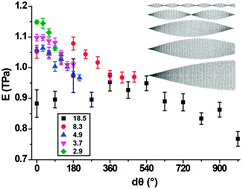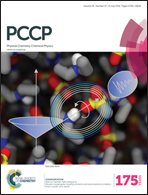Super flexibility and stability of graphene nanoribbons under severe twist†
Abstract
The structure and properties of nanostructured materials formed upon deformation are determined to a great extent by the states of stress and strain and the regimes of deformation. The nanostructures and properties of the graphene nanoribbons (GNRs) subjected to severe twist deformation were studied using molecular dynamics (MD) simulations. The GNRs show superflexibility and withstanding severe twisting, which leads to GNR nanostructures transforming from flat to twisted and then getting thoroughly coiled and fail. The appearance of a decreasing Young's moduli of the GNRs was observed with increasing rotation in general. The chirality has little effect on the Young's moduli of flat GNRs, whereas the degree of the GNR aspect ratio does. The severely twisted GNRs follow a similar rule but with slightly decreased Young's moduli (∼0.1 TPa), which demonstrates that the twisted GNRs maintain their stiff nature. The electronic properties of the GNRs under severely twisted conditions also show slight changes studied by density-functional theory (DFT) simulations. The stable mechanical properties and structure changes of GNRs under severely twisted conditions makes them a good candidate in some polymers, enhancing the load transfer and interfacial bonding by adding the twisted GNRs.



 Please wait while we load your content...
Please wait while we load your content...